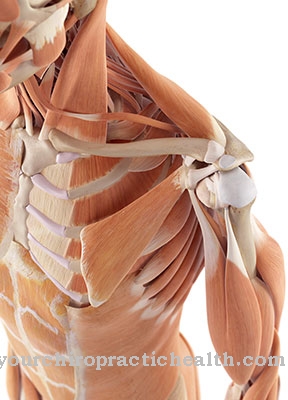The very rare one Senior Løken Syndrome (SLSN) embodies one of many possible forms of hereditary ciliopathy. The autosomal recessive hereditary syndrome is characterized by the association of nephronophthisis, a special form of interstitial kidney inflammation and retinal degeneration (retinal dystrophy). Depending on the type of genetic defect, symptoms of retinal degeneration appear during or shortly after birth or later in childhood.
What is Senior Løken Syndrome?

© SciePro - stock.adobe.com
The Senior Løken Syndrome (SLSN) represents one of about 20 known forms of ciliopathy. It is differentiated from other forms of ciliopathy in the simultaneous occurrence of nephronophthisis (interstitial inflammation of the kidneys) and retinal dystrophy with severe to extremely severe impairment of vision.
An exact differentiation of the SLSN from other ciliopathies is not always possible because there are genetic and phenotypic overlaps with other ciliopathies. Cilia play a major role in the movement of cells and in the extracellular "transport" of solid and liquid substances, as well as in many sensory processes as impulses.
Cilia are cytoplasmic protuberances of the cell membrane. Ciliopathies, functional disorders of the cilia, therefore have an almost systemic effect on many metabolic processes and on sensory performance. Retinal degeneration, which is associated with Senior Løken Syndrome, has two different forms.
Leber's amaurosis is the more serious form, which is already noticeable during and shortly after birth due to visual field restrictions and weakened pupil reactions as well as nystagmas.
causes
Like many other ciliopathies, Senior Løken Syndrome is caused exclusively by oligogenic to polygenic defects. Overall, the focus is on mutants of seven different genes at different loci as triggers of SLNS. In the future, other genes could be added because research in this area has not yet been completed.
The genes that code for proteins in the cilia have a major influence on the development and thus also on the functionality of the photoreceptors in the retina and on the cells of the tubular epithelium of the kidneys. Since the disease is inherited in an autosomal recessive manner, it can only occur if the genetic defects are present on both chromosomes and collide.
With the combination of a “healthy” gene and a mutated gene, the coding of the non-mutated gene prevails, so that the SLNS does not appear, although the genetic predisposition is latent.
There is (still) no complete understanding of the connections between the genetic defects that lead to the outbreak of the disease. Also under discussion are epistatic interaction chains of certain genes, i.e. interactions of certain, non-homologous genes with one another.
Symptoms, ailments & signs
Symptoms of SLSN usually appear shortly after birth or during the child's developmental phase. Because the kidneys and retina are equally affected, signs and complaints manifest in parallel in both organ systems, the kidneys and the eyes (retina).
Typically, signs of polyuria, abnormally increased urine excretion and the associated polydipsia, an increased fluid intake, can already be seen shortly after birth. Signs of retinal dystrophy usually show up immediately after birth in the form of visual field restrictions and weak pupillary reflexes.
In many cases, nystagmas are also observed, cascading, jerky movements of the eyes that are normally triggered by impulses from the semicircular canals in the inner ear when accelerating. The symptoms that appear on the kidneys and retina are caused by the progressive degenerative processes of the functional cells of the renal epithelium and the photoreceptors in the retina of the eyes.
Diagnosis & course of disease
The symptoms that develop in connection with SLSN are not very specific and could indicate a number of other diseases as well. Therefore, comprehensive examinations such as kidney function tests, laboratory tests of the urine and an ultrasound of the upper abdomen are recommended for clarification.
If the examination takes place in infancy, a liver function test is also recommended in order to rule out liver fibrosis. With regard to the eyes, examinations of the fundus, visual acuity, field of vision and color vision are used to differentiate from other diseases. An electroretinogram and the measurement of involuntary eye movements complete the examinations.
The course of the SLSN is mainly determined by the progress of the degeneration of the functional kidney tissue. While the breakdown processes in the retina ultimately lead to blindness, the prognosis of the overall course of the disease is very unfavorable due to the breakdown processes in the kidneys - if left untreated.
Complications
Because of Senior Løken's syndrome, those affected primarily suffer from severe visual problems. As a rule, these occur immediately after birth, so that those affected already suffer from significant restrictions in everyday life and thus also from development in childhood. In the worst case scenario, it can lead to complete blindness.
In many cases, the patients are dependent on the help of other people in their everyday life and, especially at a young age, cannot easily do many everyday things. This can also lead to psychological complaints or depression. Furthermore, symptoms of this syndrome also occur in the kidneys, so that the patients can suffer from renal insufficiency. In the worst case, this can lead to death of the person concerned.
The patients are then dependent on a kidney transplant or dialysis. As a rule, Senior Løken syndrome always leads to a complete loss of vision, which cannot be treated. The kidney problems can be limited with a supportive healthy lifestyle. However, in most cases the patient's life expectancy is significantly reduced by the syndrome.
When should you go to the doctor?
Senior Løken syndrome must always be treated by a doctor. In most cases, this disease cannot heal itself, so that the person concerned is always dependent on medical treatment. Since Senior Løken syndrome is a genetic disease, genetic counseling should also be carried out if you want to have children in order to prevent the syndrome from being passed on to your descendants. A doctor should be consulted if the person concerned suffers from eye discomfort.
These symptoms appear for no particular reason and do not go away on their own. Furthermore, symptoms of the kidneys also indicate Senior Løken's syndrome and must also be checked by a doctor if they occur together with the eye problems. If the senior Løken syndrome is not treated, in the worst case scenario, the affected person can become completely blind. Therefore, early detection of the syndrome is very important.
In the case of Senior Løken Syndrome, a general practitioner can primarily be seen. Further treatment is then carried out by an internist or an ophthalmologist.
Treatment & Therapy
If the diagnosis of SLSN is positive, it is important that the affected children undergo regular kidney function tests in order to be able to recognize the gradual progression of the disease. Since there is currently no known medicinal substance that could cure juvenile nephronophthisis, all treatment methods are initially aimed at combating symptoms and relieving pain.
A controlled supply of salts is important in order to keep the electrolyte balance in a balance, which can shift due to the constant loss of fluid. If the progression of the disease has reached a critical stage, short-term and recurring dialysis can be life-saving. The only long-term therapy that can be considered is a kidney transplant.
Also for the treatment of the retinal problems that develop parallel to the kidney problems, no drug or other treatment is known that could slow or even stop the progression of the retinal dystrophy. The prognosis for the progression of retinal dystrophy is therefore poor. Ultimately, the disease always ends with a total loss of vision, i.e. with complete blindness.
prevention
Senior Løken syndrome is solely due to genetic causes. Any precautionary measures such as dietary changes or preventive medication would not be effective. In principle, a prenatal diagnosis is possible if the genetic defects in the family are known and appropriately documented.
Aftercare
Therapy for Senior Løken Syndrome goes straight to the aftercare phase, during which the sick children have to be examined regularly. The parents are responsible for meeting the deadlines for the kidney function test. They should closely follow doctor's recommendations to relieve their children's symptoms and pain.
The disease is hereditary, so that a change in diet only improves the body feeling, but has no direct influence on the symptoms. Nevertheless, parents should ensure a good electrolyte balance and, for this purpose, take the salts prescribed by the doctor. In this way, the increased loss of fluid can be compensated.
Regular dialysis appointments should be made depending on the severity of the disease. The sick children often feel weakened and need appropriate support. In the context of family planning, genetic counseling is useful if the genetic defect is known. This point also plays a relevant role in the combined prevention and aftercare.
Involving family members and friends helps the affected children with everyday problems. At the same time, security increases if the social environment is informed about the disease. In connection with the negative impact of the disease on the eye retina, psychotherapy can be useful.
You can do that yourself
Children who suffer from Senior Løken Syndrome need particularly loving support in everyday life.Above all, parents should make sure that the kidneys are regularly checked for their function. This allows the progress of the disease to be reliably identified. As part of prenatal diagnostics, if the genetic defect is known, an appropriate test can be carried out.
However, the hereditary disease cannot be prevented or stopped with a healthy diet or certain medication. In everyday life it is important that patients receive controlled salts. These ensure a balanced household of electrolytes and prevent them from being flushed out due to the continuous loss of fluid. At an advanced stage of the disease, critical situations may arise. Dialysis is then essential. Often the children get used to the recurring dialysis at a young age. Still, many parents hope for a kidney transplant to make life easier for their children.
In addition to kidney problems, the negative development of the eye retina plays a role. Unfortunately, no successful drug therapy is known for this so far, so that the retinal dystrophy is progressing. Due to the poor prognosis of the disease, psychological support is recommended for the affected families.





.jpg)





















